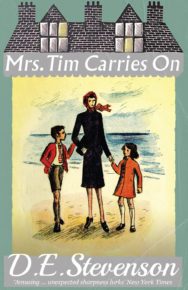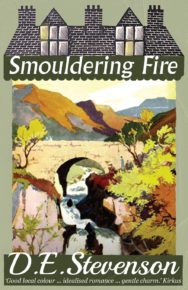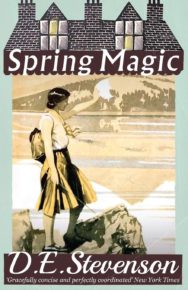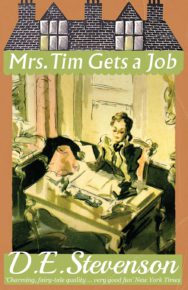‘She had nothing to drag her out of bed in the morning, and, therefore, like a sensible woman, she breakfasted late.’
BooksfromScotland is carrying on with its new strand, ‘Rediscovering’, bringing back into focus authors from the past whose books still deserve a spotlight shone on them. This month Lee Randall takes a look at D E Stevenson, a writer who sold more than her more famous second cousin in her day. But with new reprintings, it looks like she may get a deserved revival.
Sam Abbott bursts in on his uncle at the publishing firm of Abbott & Spicer, waving a manuscript, declaring, ‘Uncle Arthur, the feller who wrote this book is either a genius or an imbecile.’
Chronicles of an English Village, purports to be by John Smith. Fans of the novel within a novel know the re-christened Disturber of the Peace is by Barbara Buncle, a mousy spinster of no importance in Silverstream. Thus when an outraged neighbourhood goes on the warpath to discover—and punish—the villager who’s made free and easy with their secrets, no one considers her a candidate.
I imagine D.E. Stevenson (1892 – 1973), author of Miss Buncle’s Book (1934), also confounded expectations. It can’t have been easy growing up clever in an age when middle-class mores dictated that a woman’s destiny was marriage. Dorothy wasn’t sent to school, but educated at home. She sat the Oxford entrance exam and received an offer, but her parents decreed further education ‘an unforgivable deterrent to potential suitors.’ No doubt they were unaware she’d been hiding in a cupboard writing books since she was eight.
Born into the Lighthouse Stevensons, she’d marry into another renowned family. In 1915 she published a collection of poetry, and around then, met James Peploe, a captain in the 6th Ghurkha Rifles, in Edinburgh on medical leave after losing most of his hearing to a head wound incurred at the Battle of Mons. (His father’s half-brother was famous Scottish Colourist, Samuel.) They married in 1916.
By 1923, when she published Peter West, the first of her 45 novels, they had three children. Nine years passed before her next novel, Mrs Tim of the Regiment, a gap possibly connected to the death of their eldest daughter, in 1928, and the arrival, in 1930, of a fourth child. From 1946, until retiring in 1969, Stevenson published a book a year, earning the bulk of the income required to run a household that included full-time help.
I bring that up because when asked why she wrote a novel, Miss Buncle’s answer is immediate and honest: ‘I wanted money.’ Her dividends have run dry; her future looks terrifying. Stevenson lets Barbara rescue herself through work, rather than via advantageous marriage, and the novel’s clear-sighted about the difficulties facing women without independent means. It also, some may be surprised to learn, includes a lesbian couple, post-natal depression, an abusive husband, and love between the middle-aged.
Stevenson was, by all accounts, as likeable as her heroines. In 2011, her daughter, Rosemary Swallow, told the BBC, ‘She would sit down on the sofa, put her legs up and light a cigarette. She had a special wooden writing board covered in green baize and would just carry on writing whatever was going on around her.’
Her industry paid off. She was one of the bestselling novelists of the 1930s, shifting seven million copies of her novels in the UK and the USA, where her fan base remains strong thanks to an active network of soi-disant ‘Dessies’.
During World War II, after Glasgow was bombed, the Peploes moved from Bearsden to 1 North Park, Moffat. (Dorothy died there in 1973.) War was a recurring subject, reflecting the times, and her husband’s background. Her successful Mrs Tim series (Mrs Tim of the Regiment, Mrs Tim Carries On, et al), sprang directly from her diaries, offering a firsthand account of a career officer’s wife.
In her master’s thesis, Love in Conflict: D.E. Stevenson, War-time Romance Fiction, and The English Air, Ingrid L Baker observes, ‘Her novels were popular and successful, which suggests that this kind of fiction met the needs of readers . . . [and] reflected how women . . . internalised and survived the uncertainty of their lives while their husbands, brothers, and friends were distant and in peril.’
Mrs Tim won critical favour, with The New York Times saying, ‘Stevenson never seems to work at being funny, but she has spiced this tale of British army with an unobtrusive, effortless wit which often proves deceptively sharp.’
Why, then, are we perpetually rediscovering Stevenson? Because she was a woman, writing about the female experience.
Scott Thompson, co-publisher of Dean Street Press’s Furrowed Middlebrow Imprint, which publishes five of Stevenson’s novels, says, ‘She has inspired passionate and often lifelong devotion in her readers. [But] most of her books were out of print before Persephone got the ball rolling by reprinting Miss Buncle’s Book. The reasons are probably the same as for so many brilliant women writers of the time. Their tendency to focus on domestic themes and the challenges and changing roles of women meant that male critics and scholars dismissed them as “women’s fiction.” If the likes of Barbara Pym and Elizabeth Taylor had lapsed out of print, what chance did D. E. Stevenson’s books—so often mischaracterised as “romances”—have?’
He adds, ‘Readers have come to realise that the canonical 20th century novels they studied only tell a fraction of the story. We were missing out not just on women’s voices and perspectives, but also on the meticulous and fascinating details of day-to-day life at pivotal historical moments.’
Like Hester Tim and Barbara Buncle, Stevenson is appealingly gemütlich. She once wrote, ‘Sometimes I have been accused of making my characters “too nice”. I have been told that my stories are “too pleasant,” but the fact is I write of people as I find them and am fond of my fellow human beings.’
For me, the defining image comes from the Bearsden Film Club’s 1930 short, Fickle Fortune. Dorothy wrote the screenplay, about Rob Roy McGregor, and plays his wife, Flora. Watch it here.
Stevenson bursts out of the cave buckling her swash for all it’s worth, rallying her clan. She injects a jolt of energy and devilry, evincing the lively spirit of mischief that’s present in her deceptively quiet novels—which surely explains their hold on successive generations lucky enough to rediscover them.
D.E. Stevensons books are published in handsome editions by Persephone Books: http://www.persephonebooks.co.uk, and Dean Street Press’s Furrowed Middlebrow imprint: http://www.deanstreetpress.co.uk/authors/stevenson.
In 2017, the Edinburgh City of Literature Trust commemorated
- E. Stevenson with a plaque installed at her childhood home on 14 Eglinton Crescent.
Backlisted Podcast #96 centred around Miss Buncle’s Book. Listen to it here: https://www.backlisted.fm
ALSO IN THIS ISSUE

 I Want to be a Machine: Warhol and Paolozzi
I Want to be a Machine: Warhol and Paolozzi
‘Paolozzi was a voracious consumer of images and information…’
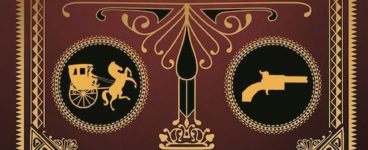
 The Art of Dying
The Art of Dying
‘He had only come to appreciate how much he missed Edinburgh once he had committed to return, and if …





